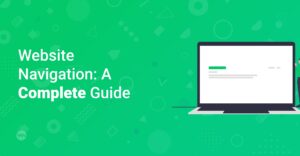Preface
In today’s digital landscape, your website is often the first interaction a potential customer has with your brand. It needs to be more than just visually appealing; it needs to be strategically designed to convert visitors into paying customers. This guide will walk you through the essential elements of designing a website that not only attracts visitors but also turns them into loyal customers.
Understanding Conversion-Centered Design
Conversion-centered design is all about guiding your website visitors towards a specific goal—whether it’s making a purchase, filling out a form, or signing up for a newsletter. It’s a holistic approach that considers every aspect of the user experience, from the layout and navigation to the content and calls-to-action (CTAs).
Key Principles of Conversion-Centered Design
- Clarity: Ensure your message is clear and easy to understand. Visitors should immediately know what your business offers and what you want them to do.
- Relevance: Tailor your content and design to your target audience’s needs and interests. Show them that you understand their problems and have solutions.
- Value: Communicate the unique benefits of your products or services. Why should visitors choose you over the competition?
- Trust: Build credibility through testimonials, security badges, and a professional design. Visitors need to feel confident that you’re a trustworthy business.
- Urgency: Create a sense of urgency to encourage immediate action. Use limited-time offers, countdown timers, or scarcity tactics.
Step-by-Step Guide to Designing a Converting Website
1. Define Your Goals and Target Audience
Before you start designing, you need to know what you want to achieve and who you’re trying to reach. Ask yourself:
- What’s the primary goal of your website? (e.g., increase sales, generate leads, build brand awareness)
- Who is your ideal customer? (Consider demographics, interests, pain points, and motivations)
Hint: Creating detailed buyer personas can help you better understand your target audience and tailor your website design to their specific needs.
2. Plan Your Website Structure and Navigation
A clear and intuitive website structure is crucial for user experience and SEO. Plan your website’s hierarchy and navigation to make it easy for visitors to find what they’re looking for.
- Homepage: Should immediately convey your brand’s value proposition and guide visitors to key sections.
- About Us: Build trust by sharing your company’s story, mission, and values.
- Products/Services: Showcase your offerings with compelling descriptions, images, and pricing information.
- Blog: Provide valuable content that attracts and engages your target audience.
- Contact Us: Make it easy for visitors to get in touch with clear contact information and a contact form.
Info: Use a sitemap to visualize your website’s structure and ensure logical navigation. Tools like Slickplan can help you create professional sitemaps.
3. Design a Visually Appealing and User-Friendly Interface
Your website’s design should be visually appealing, user-friendly, and consistent with your brand identity. Consider the following elements:
- Color Scheme: Choose colors that align with your brand and evoke the right emotions. Use a limited palette (2-3 primary colors) for consistency.
- Typography: Select fonts that are readable and complement your overall design. Use a mix of heading and body fonts for visual hierarchy.
- Imagery: Use high-quality images and videos that showcase your products or services and resonate with your target audience.
- White Space: Use white space (negative space) to create a clean and uncluttered design. White space improves readability and highlights important elements.
- Mobile Responsiveness: Ensure your website is fully responsive and looks great on all devices (desktops, tablets, and smartphones).
Info: A responsive website adapts its layout and content to fit the screen size of the device it’s being viewed on. This is crucial for providing a seamless user experience across all devices.
4. Craft Compelling and Persuasive Content
Your website’s content should be clear, concise, and persuasive. Focus on the benefits of your products or services and how they solve your customers’ problems. Use the language that resonates with your target aundience.
- Headlines: Use attention-grabbing headlines that clearly communicate the value proposition.
- Body Text: Write clear and concise body text that’s easy to read and understand.
- Bullet Points: Use bullet points and lists to break up large blocks of text and highlight key information.
- Testimonials: Include testimonials and social proof to build trust and credibility.
- Case Studies: Share case studies to demonstrate the effectiveness of your products or services.
5. Optimize for Search Engines (SEO)
Search engine optimization (SEO) is crucial for driving organic traffic to your website. Optimize your website’s content and structure to improve its ranking in search engine results pages (SERPs).
- Keyword Research: Identify relevant keywords that your target audience is searching for.
- On-Page Optimization: Optimize your website’s title tags, meta descriptions, headings, and content with relevant keywords. Learn more through this helpful quickstart guide for WordPress on how to optimize your website for SEO.
- Image Optimization: Optimize your images by using descriptive file names and alt text.
- Link Building: Build high-quality backlinks from other reputable websites.
Info: SEO is an ongoing process. Continuously monitor your website’s performance and make adjustments as needed to improve your search engine rankings.
6. Implement Clear Calls-to-Action (CTAs)
Your website should guide visitors towards specific actions with clear and compelling CTAs. Use action-oriented language and visually prominent buttons to encourage clicks.
- Placement: Place CTAs in prominent locations, such as above the fold, within the content, and at the end of pages.
- Design: Use contrasting colors and bold fonts to make your CTAs stand out.
- Wording: Use action-oriented language that encourages clicks (e.g., “Shop Now,” “Get a Free Quote,” “Download Now”).
- Value Proposition: Clearly communicate the value of taking the desired action (e.g., “Get a Free Ebook,” “Start Your Free Trial”).
7. Test and Optimize Your Website
Testing and optimization are crucial for improving your website’s conversion rate. Use analytics tools to track user behavior and identify areas for improvement.
- A/B Testing: Test different versions of your website’s elements (e.g., headlines, CTAs, images) to see which performs best.
- Heatmaps: Use heatmaps to see where visitors are clicking and scrolling on your website.
- User Feedback: Collect user feedback through surveys, polls, and user testing.
- Analytics: Use analytics tools like Google Analytics to track key metrics such as bounce rate, time on site, and conversion rate.
Hint: A/B testing involves creating two versions of a webpage and showing each version to a different segment of your website visitors. By tracking which version performs better, you can make data-driven decisions to improve your conversion rate.
8. Leverage Page Builders and Starter Templates
To expedite the design process, especially if you’re using WordPress, consider utilizing page builders like Elementor Page Builder and starter templates. Check out these beautiful websites built with Elementor as inspiration.. These tools offer drag-and-drop functionality and pre-designed layouts, allowing you to create professional-looking websites quickly and efficiently. And if you are using Astra Theme check out how to install Astra Starter Templates.
Conclusion
Designing a website that converts visitors into customers requires a strategic approach that considers user experience, SEO, and persuasive design principles. By following the steps outlined in this guide, you can create a website that not only attracts visitors but also guides them towards your desired goals. Remember to continuously test and optimize your website to ensure it’s performing at its best and delivering the results you need to grow your business. Starting making websites today can be a game changer for your business!



